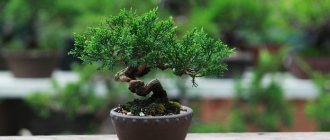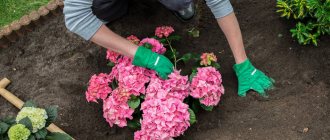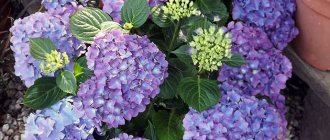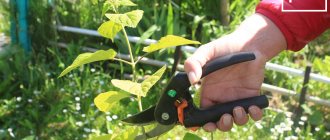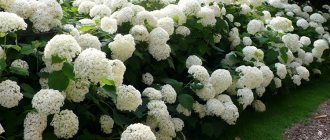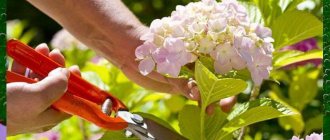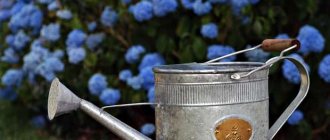By properly caring for hydrangea shrubs in the spring, immediately after the end of winter, gardeners allow the plant to lay a large number of flower buds. In order not to subsequently wonder why an adult lush hydrangea does not bloom in the garden and what it lacks, you need to follow the rules of agricultural technology.
Hydrangea feeding must be carried out evenly in the spring (after winter, a shock dosage of microelements and organic lignins is given) and throughout the summer so that the shrub grows new vegetative mass.
Read about how to properly care for beautiful hydrangeas in your country house and garden in this material, which describes the basics of spring agricultural technology.
Flowering of ngortensia after proper and timely feeding during spring plant care
You can achieve pink and blue flowering by adjusting the amount of microelements and the composition of the fertilizer
Perennial large-leaved and paniculate hydrangea is a luxurious home and garden plant. Mostly miniature species are grown at home. In the garden, large bush plants of the Garden or Tree varieties are more often found. The flower has a peculiarity: its inflorescences react to changes in soil composition. On acidic soils they take on a blue tint; on neutral soils they become white or pink. This must be taken into account when choosing fertilizers for spring and summer feeding, because by maneuvering the compositions, you can significantly diversify the colors of the buds. Fertilizers for hydrangea in spring and summer are simply necessary during the active life cycle for its abundant flowering.
The main reasons why hydrangea does not bloom
Sometimes hydrangeas don't bloom because they don't have enough nutrients. There are a number of reasons. Some of them are worth taking into account, since, for example, if the root system of a flower rots or weakens, the plant does not bloom and cannot be fertilized. Remember that not everything depends on the quantity and quality of fertilizing. Although they often become the reason for the lack of budding. Let's figure it out why this happens.
If in the spring the plant begins to quickly gain green mass, and the flower buds do not turn into buds, then the hydrangea has overwintered in unsuitable conditions. The plant does not tolerate temperature drops to 0° and below. Under such conditions, flower buds freeze and may die. Therefore, in the fall, after the last fertilizing of the season has been applied and the perennial has faded, it is covered with insulating materials. In colder regions, such as the Urals, more drastic measures are required. They try to hide low hydrangeas from the cold at home. Tall ones are grown in greenhouses and greenhouses.
The reason for the lack of flowering of hydrangeas may be improper pruning. This disease occurs more often on newly purchased specimens. Pruning is carried out in the spring, clearing the plant of old and wilted stems. Under no circumstances should you cut off last year's strong shoots. Hydrangea flowers form on them. If you do this, you can see the perennial blooming closer to autumn or the next season.
The root system of hydrangeas is very powerful. Its development affects the budding of the plant. If it is weakened or develops in clay soil, then the plant may not bloom, stocking up on strength to overcome unsuitable conditions. Also, budding can be affected by the external environment. For example, hydrangeas do not bloom in extreme heat and in insufficient soil moisture. You should not be overzealous with watering, since the plant also does not tolerate waterlogged soils.
Feeding should be timely and in optimal quantities. They can also greatly affect the development of hydrangea buds. If you apply nitrogen fertilizers in the spring, this will significantly delay the appearance of flowers on the bush. In summer, such fertilizing enlarges the inflorescences, but this has a bad effect on decorativeness, since the stems lie down under the weight of the flowers.
Watering
Water hydrangeas with settled water
Hydrangeas are considered moisture-loving plants, although the experience of gardeners shows that many of them can withstand moderate moisture and even short-term drought. However, in the spring, especially like this season, plants require spring watering. After a practically snowless winter, the supply of moisture in the soil is very small, so in warm spring conditions the plants will very soon experience problems.
For watering, use settled, sun-warmed water; it is not advisable to water hydrangeas directly from a well or from a well with ice water. To acidify neutral soil, you can add a little citric acid or vinegar, although this shrub grows well on slightly acidic and even neutral soils; it cannot withstand only alkaline soils. When watering, move away the layer of mulching material, and then cover the moistened soil with it again.
Give your hydrangeas some time in early spring to enjoy long, lush blooms in the summer.
How to fix a problem with a houseplant?
Garden perennials in warm regions differ from indoor perennials in their easier and faster development. Hydrangea becomes picky at home too. Here, not only the temperature of the room air and periodic feeding are important for her, but also the lighting and even the location in the house.
Most often, the cause of wilting and death of a plant in protected soil is the unsuitable composition of the soil. The mixture can change its alkaline and acid levels when watered with tap water. Under no circumstances should this be done, especially if you live in a big city. For indoor plants, choose acidic soils; loam is ideal. In order for the hydrangea to acquire a blue tint, it is watered with melt water with the addition of acetic or citric acid. Some gardeners recommend choosing soil for home hydrangea with a high peat content before solving the problem.
Annual replanting to a new location with renewal of the nutrient soil is an important necessity. As for external conditions, the plant does not tolerate darkening and dry air. Lack of watering is detrimental to it. In order for hydrangea to bloom all summer at home, it is necessary to periodically spray it with melted warm moisture. To avoid getting on the inflorescences, you can wipe the leaves with a damp, lint-free cloth.
The reason why hydrangea does not bloom indoors may be the age of the plant. We recommend updating it at least once every 4-5 years. At this age, the perennial can begin to grow and spends less energy on budding. Therefore, experienced gardeners, using vegetative propagation methods, renew the shrub. The same goes for garden perennials.
Transplanting hydrangea after winter to another place
Hydrangea is transplanted to another place in the spring, before the flowering season begins. The optimal time is from late March to early April. At this time, the soil may not warm up enough and be hard, so you need to prepare for spring planting in the fall. Before transplanting hydrangea, you need to prepare the bush:
- When the bush has finished blooming, gather the branches into a bunch, press them tightly together and tie them in a circle with a thick rope;
- A narrow ditch is dug around the trunk within a radius of 40-50 cm to a depth of 20-30 cm. You need to pour compost into it and fill it well with water. For large shrubs, a ditch is dug at a distance of 50-70 cm from the trunk;
- In spring, the bush is dug up along with a large ball of earth so as not to damage the root system.
How to propagate hydrangea by cuttings in spring
In the fall, you need to prepare a new place for planting. The new area must be no worse than the previous one, otherwise the plant will not take root. How to properly prepare the ground:
- A new place for shrubs needs to be dug up and loosened, weeds and debris removed;
- The soil is mixed with organic substances such as coarse sand, peat, and pine needles. To plant 1 shrub you need from 3 to 5 kg of any of these components;
- The soil must be fertilized with superphosphate or any mineral composition. Over the winter, all the additives will react with the soil, and in early spring the area will be ready for planting hydrangeas.
Note! A large shrub can be used for propagation. To do this, the dug bush is divided into several parts. The roots must be washed; when dividing, they cannot be cut in half. All pieces are planted in different places.
How to properly transplant hydrangea, step-by-step instructions:
- In the prepared area, dig a hole for planting, at least 50x50 cm in size, and the same depth. The roots of the plant should be freely accessible to it;
- At the bottom of the pit there should be a drainage layer of pebbles or brick chips;
- The soil for backfilling should consist of deciduous soil, coarse sand and humus in a ratio of 2:1:1. Little backfilling is needed, since the bush is replanted along with a lump of earth;
- The dug bush is carefully placed in the hole, the voids are filled with prepared backfill;
- The soil needs to be compacted with your hands by slightly tapping the surface. Be sure to install 1-2 supports to which the bush is tied, otherwise it will fall over;
- The ground around the bush is mulched with sawdust, small branches or bark;
- The transplanted shrub is watered every other day, regardless of the weather. 10-15 liters of settled water are poured onto 1 bush.
Note! Every 10 years you need to replant an adult shrub to a new place.
Frequency of application of nutritional supplements
To maintain abundant flowering of hydrangeas, you need to apply nutritional fertilizers three times a year. This frequency greatly facilitates the care of perennial indoor and garden plants. The first fertilizers are used in the spring, when the plant begins to grow and green leaves begin to appear. Ready-made fertilizers with a high nitrogen content are used as mineral complexes. This element gives a good effect and supports the development of green tops, especially in garden hydrangeas. Potassium is also of great importance in the spring.
In summer, when active budding occurs, approximately the same amount of nitrogen fertilizers and potassium is required. But when hydrangea blooms, phosphorus becomes its most important element. Also, at this time, you can adjust the shade of the buds by lowering or increasing the acidity using special complexes. On neutral soils, hydrangea turns white. High nitrogen affects this plant very differently than other perennials. The fact is that with a large amount of this element, the plant’s inflorescences become very large. But this has an adverse effect on the appearance of the shrub, since under the weight of the flowers the stems droop and can break.
The summer period of organizing care involves periodically feeding hydrangeas with organic substances. Kemira Tsvetochnaya has proven itself best as ready-made complexes. During the entire summer, fertilizing should be no more than three procedures. Milk, kefir or whey can be used as non-standard fertilizers, since the plant often requires lactic acid.
In autumn, one of the most important fertilizing procedures is carried out. It is necessary for the bush to lay new flower buds and bloom profusely the next season.
When to water
Watering in spring is very important for hydrangeas, especially if the winter was frosty and dry. They begin to water the bushes in warm weather, observing the following rules:
- Even if it rains in the spring, the plants need to be watered every 10 days. In dry weather, the bushes are watered once a week.
- Each plant consumes 12-15 liters of water.
- Spring watering of hydrangeas is carried out with settled warm water (30..35 degrees).
- To protect shrubs from diseases, you can add a little potassium permanganate to the water. The solution should be slightly pink. You can use this solution three times in the spring.
You will be interested to know: Feeding garden hydrangea in the summer in June, July, August for lush flowering and color change
Fertilizing in spring in the garden
Garden hydrangea is one of the most popular types of plants from the entire vast genus of Hydrangeaceae. In spring, perennials require special care and attention, as this is the most important period. We can say that at this time of year the hydrangea “decides” whether it will bloom or not. Therefore, pay attention to the fact that right now one of the key feedings of the plant is required.
For 10 liters of clean water, take a tablespoon of potassium sulfate and urea. This solution contains the optimal amount of nitrogen, which is currently necessary for the growth of green mass. Follow the recommended proportions so as not to spoil the bush. Apply no more than 5 liters of solution per rhizome. It is advisable that the water be warm - room temperature. Nutrients are added strictly before the buds appear. It is best as soon as the snow melts in the garden in the spring.
To ensure abundant flowering of hydrangeas in the spring, the plant is fertilized with mineral complexes. It is important that they contain sufficient amounts of potassium and phosphorus. During the period when the plant is preparing for budding, it is necessary to reduce the amount of nitrogen fertilizing. They can adversely affect the development of flowers. Superphosphate is suitable as a mineral composition. Three times in the spring you need to water the bush with a solution of potassium permanganate. This is necessary so that the plant develops more resistant to diseases and its stems are more flexible and resilient.
Bush pruning
Any variety of hydrangea requires pruning, but each type has its own characteristics for carrying out this procedure. This serious operation should not affect the shoots that are responsible for the formation of inflorescences.
Domestic gardeners mainly use tree-like and paniculate varieties of hydrangeas. They form inflorescences on newly formed shoots. Therefore, in April, immediately after the snow melts, they are subject to mandatory pruning. You need to be in time before the sap begins to flow, otherwise the plant will literally bleed out juice.
The tree-like bush is pruned to 5 buds. To thicken, some shoots are cut down to the very base of the soil. The gentle pruning method involves cutting off only last year's faded inflorescences and shoot tips. In this case, many inflorescences are formed this year, but their diameter becomes smaller. During the pruning process, it is important to remove twisted, dead and weak shoots.
For paniculate bush plants, pruning performs formative and sanitary functions. The extent of the procedure is reflected in the flowering period and its quality. When severely pruned to two buds, the hydrangea blooms later, but blooms more powerfully. Moderate pruning to four buds gives average flowering time and volume. Light pruning involves cutting off only past inflorescences.
Each variety and appearance of the plant itself requires an individual approach to the pruning process. Here it is important to take into account the condition of the flower and the desired result in terms of timing and abundance of flowering. In any case, this is a creative process with an individual approach to each plant.
Rare, particularly heat-loving varieties of hydrangea, for example, Dubolistnaya, Sargenta, Chereshkovaya and Serrated, require only sanitary cutting after the buds have swollen to improve the health of the entire bush and its aesthetic appeal.
Summer feeding of hydrangea
Summer is the time when hydrangea blooms very profusely, long and luxuriantly. To support the budding process, you need to organize periodic feeding for the perennial. Some gardeners use organic matter in the summer. But you need to be very careful with it, as it contains a large amount of nitrogen. As an organic complex, you can use diluted bird droppings or slurry. Dilute the component in warm water in a ratio of 1:10. No more than 5 liters of solution are poured under one bush.
Summer feeding occurs no more than once a month. You can use complex mineral compositions. Kemira has proven herself well. It contains a lot of useful nutrients. To increase the acidity of the soil and to make the hydrangea change color, you can use non-standard fertilizers. For example, to make the plant color the inflorescence blue, you can feed the perennial with soaked bread. But first, wait until the mixture infuses and sours.
How to feed hydrangea in spring
After removing the mulch layer, you need to give the first fertilizing. Fertilizers for hydrangeas can be applied in dry or liquid form (following the instructions on the package).
Hydrangeas really like the balanced NPK complex “nitrogen-phosphorus-potassium” + micro, such as the drug Fertika Kristalon. It is easily diluted in water, does not contain chlorine, and is convenient to use for spraying bushes.
Excellent universal fertilizers for hydrangeas are Organic Mix and Agricola Aqua. NPK complex 5:3:1 + micro provides a supply of nutrition for three months and balances soil pH, promoting lush and vibrant flowering.
After applying the fertilizers, the soil is watered abundantly and covered with a fresh layer of mulch (shavings, peat, sawdust) 7-10 cm high.
Fertilizers for hydrangeas in the fall: preparing for winter
In autumn, hydrangea is prepared for a long period of winter dormancy. At this time, the perennial begins to lay flower buds for the next year. Therefore, the plant simply needs fertilizers. We recommend choosing formulations with a high content of potassium and phosphorus. You can use superphosphate or potassium sulfate. Phosphorus helps the plant to lay as many flower buds as possible in the fall. Potassium is needed for the root system so that it can survive the cold.
For 10 liters of clean water, preferably warm and melted, take 1 tbsp. a spoonful of potassium sulfate and superphosphate. One bush accounts for no more than 7 liters of the resulting solution. You need to apply nutritious fertilizers only after the hydrangea has bloomed. The perennial does not need nitrogen in the fall. On the contrary, it can cause the death of a flower in the cold season. The fact is that nitrogen makes the perennial grow faster. If you feed hydrangea in the fall with nitrogen complexes, it will begin to rapidly grow shoots, which is completely unacceptable when preparing a perennial for winter dormancy.
In the fall, you can mulch hydrangea with natural organic matter. Manure and peat have proven themselves best. The mulch level should be no more than 5 cm. It helps hydrangea survive a strong drop in soil and air temperatures.
Look at the video further on the page on the basics of applying spring fertilizing to hydrangea bushes after winter and throughout the summer:
When to open hydrangea in spring
The least winter-hardy of all varieties is large-leaved hydrangea. It requires serious winter shelter, like roses - of the air-dry type. The cover must be removed gradually. With the first thaw in April, the plant is ventilated, allowing it to get used to the fresh air. With the onset of confident warmth, the duration of ventilation is increased. It is possible to remove the cover completely only when the buds begin to grow. If suddenly spring presents a “surprise” in the form of frost, the bushes must be covered with a layer of non-woven material.
After you remove the entire winter shelter, do not forget to remove the old mulch layer and loosen the tree trunk (full breathing is very important for hydrangea roots in spring). You need to loosen it carefully, since the roots are located superficially and are easily damaged.
Fertilizer application timing
The first feeding of hydrangea in the spring is designed to stimulate active plant growth, and therefore has a high nitrogen content. After 2 weeks, the flower is watered with compounds that strengthen the wood. If necessary, additionally acidify the soil. The next treatment of hydrangeas is carried out in late spring to accelerate the growth of bush shoots. Approximate feeding scheme for hydrangeas:
- from April 10 to April 18 - nitrogen-containing preparations;
- May - spraying with compounds containing manganese, which strengthens the shoots and makes them flexible;
- early June - comprehensive plant nutrition, including a set of components necessary for growth and development.
Spring pruning of hydrangea: video and tips
How to properly prune hydrangeas in the spring depends on whether you trimmed the bushes in the fall or not. If you skipped autumn pruning, you will need to carefully carry out this procedure in the spring.
Three types of spring pruning of garden hydrangea:
- Sanitary. Inspect the bush carefully and remove all dry, diseased and frozen shoots.
- Pruning for flowering or pinching. To obtain lush flowering, last year's shoots need to be shortened. They are cut off above the 4-5 buds. That is, they count four or five buds from below and cut the branch above them.
- Rejuvenating. Old shoots that are more than four years old are removed. Pruning is carried out at a height of 10 cm from the ground.
Attention! Young hydrangeas are not pruned for the first two years. In the spring, only dry, weak and damaged shoots need to be removed.
VIDEO OF PRUNING GARDEN HYDRANGEA IN SPRING
